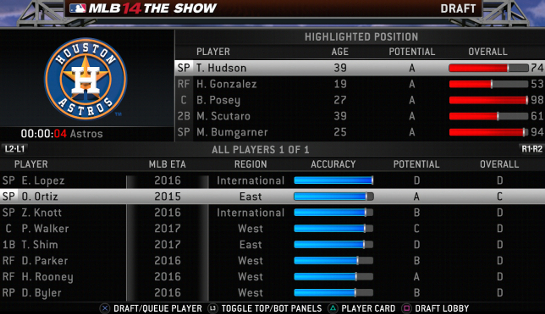Some Details On How Online Franchise Will Work in MLB 14: The Show

In terms of logistics getting an Online Franchise mode right would appear to be more difficult with baseball than the other sports that have attempted it thus far. The long seasons require compression – or some other form of realistic simulation – and that can dramatically alter the way rotations, fatigue, and injuries have to be handled.
SCEA today released some details on the structure of Online Franchise. Aspects such as league settings, scouting, live draft, and free agency are touched on in the developer blog. There are many more questions that remain unanswered on whether Online Franchise will turn out to be viable in The Show such as how rotations, injuries and fatigue are affected by having an “open” schedule (and whether the online performance and reliability is good enough to sustain interest over the long term) but this is good start at outlining the mode.
Franchise Mode has been an MLB The Show staple for quite some time now, and this year, we’re excited to introduce its long-awaited online version. We took the team-building aspects of Franchise, such as scouting and offseason contract negotiations, and merged them with the customizable schedules and divisional alignments of Online Leagues. We also continued to refine the game logic that governs trade values, lineups, player generation, and more. Let’s go over some of the main features in more detail.
LEAGUE CREATION
When you create an Online Franchise, you automatically become the league’s Commissioner. You’ll get to choose the divisional alignment, schedule type, Designated Hitter preference and whether or not to upload a custom roster, among other things. Once you’re happy with your settings, you’ll need to invite other players to the league, and also determine what teams will be controlled by the CPU (if any at all).DRAFT
Building a successful team in Online Franchise is as much about what happens on the field, as about what happens off the field. One of the most important things you can do to remain competitive is to draft amateur players effectively, in order to keep replenishing your major league roster with top-tier talent. To do this, you’ll need to scout players throughout the regular season so that you don’t go into your live online draft unprepared. Without proper scouting reports, you’ll have a much tougher time trying to distinguish between future superstars and draft-day busts.The vast majority of your drafted players will need some seasoning in the minors before they’re ready for The Show, so we’ve given you access to full minor league rosters. You’ll be able to move players up and down from Class-A all the way to the Majors, set training assignments, and also pull-off trades with other teams. Our trade logic has been greatly improved as well, so forget about lopsided trades involving three top prospects for an average major league middle reliever.
OFFSEASON
This brings us to the offseason, which we divided into two parts. In Part 1, you will handle all of your contract renewable players, arbitration cases and draft pick signings. Our player contract logic has received a much needed overhaul, as we made MLB service time more of a factor when determining player interest and ideal salary. One example where this is really noticeable is when trying to offer contract extensions to your young players. In the past, you were able to sign young superstar players to extremely cheap long-term contracts, which is unrealistic in today’s MLB. Now, you’ll still be able to lock these players up early in their careers, but you’ll have to pay something much closer to their market value. This type of contract is becoming much more common in real-life lately, with teams like the Rays and Braves leading the way, and it was important for us to incorporate this new dynamic into the game.Free agent signings happen in Part 2 of the offseason, which is divided into an adjustable number of rounds, or advancement periods. Every team gets a chance to make their best offer, and then the commissioner advances to the next round.
Players will either sign with a team, or they will remain on the market for the next round. The bidding wars that occur in this part of the offseason can become pretty intense, coupled with the fact that you’re competing against other human opponents makes the bidding all the more entertaining.
MISC
Rounding out the whole package is our expanded record keeping, as we now store draft classes, retired players, and additional career stats and awards on the Player Card. In addition, League Events and Notifications will keep you up to date on what’s happening around the league, and what tasks you need to perform to manage your team properly.
